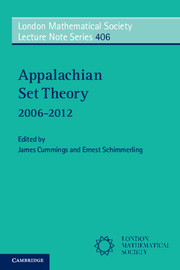Book contents
- Frontmatter
- Contents
- Contributors
- Introduction
- 1 An introduction to ℙmax forcing
- 2 Countable Borel equivalence relations
- 3 Set theory and operator algebras
- 4 A tutorial on Set Mapping Reflection
- 5 An introduction to hyperlinear and sofic groups
- 6 Aronszajn trees and the SCH
- 7 Iterated forcing and the Continuum Hypothesis
- 8 Short extender forcing
- 9 The complexity of classi?cation problems in ergodic theory
- 10 On the strengths and weaknesses of weak squares
- 11 Proper forcing remastered
- 12 Set theory and von Neumann algebras
- 13 The HOD Dichotomy
5 - An introduction to hyperlinear and sofic groups
Published online by Cambridge University Press: 05 December 2012
- Frontmatter
- Contents
- Contributors
- Introduction
- 1 An introduction to ℙmax forcing
- 2 Countable Borel equivalence relations
- 3 Set theory and operator algebras
- 4 A tutorial on Set Mapping Reflection
- 5 An introduction to hyperlinear and sofic groups
- 6 Aronszajn trees and the SCH
- 7 Iterated forcing and the Continuum Hypothesis
- 8 Short extender forcing
- 9 The complexity of classi?cation problems in ergodic theory
- 10 On the strengths and weaknesses of weak squares
- 11 Proper forcing remastered
- 12 Set theory and von Neumann algebras
- 13 The HOD Dichotomy
Summary
The seventh Appalachian Set Theory workshop was held at Cornell University in Ithaca on November 22, 2008. The lecturer was Vladimir Pestov. As a graduate student Aleksandra Kwiatkowska assisted in writing this chapter, which is based on the workshop lectures.
Abstract
This is an edited write-up of lecture notes of the 7-th Appalachian set theory workshop of the same title led by the first named author at the Cornell University on November 22, 2008. A draft version of the notes was prepared by the second named author. This presentation is largely complementary to the earlier survey by the first-named author (Hyperlinear and sofic groups: a brief guide, Bull. Symb. Logic 14 (2008), pp. 449–480).
Motivation: group matrix models in the sense of classical first-order logic
In these lectures, we will deal with a class of groups called hyperlinear groups, as well as its (possibly proper) subclass, that of sofic groups. One natural way to get into this line of research is through the theory of operator algebras. Here, the hyperlinear groups are sometimes referred to as “groups admitting matrix models”. This can be indeed interpreted as a genuine model-theoretic statement, within a suitable version of logic. Namely, a group G is said to admit matrix models if every existential sentence of the first-order theory of G is satisfied in matrix groups.
What makes the concept interesting — and difficult to work with — is that at the matrix group end it is not the classical first-order logic that one has in mind, but rather a version of continuous logic with truth values in the unit interval [0; 1].
- Type
- Chapter
- Information
- Appalachian Set Theory2006–2012, pp. 145 - 186Publisher: Cambridge University PressPrint publication year: 2012
- 7
- Cited by

